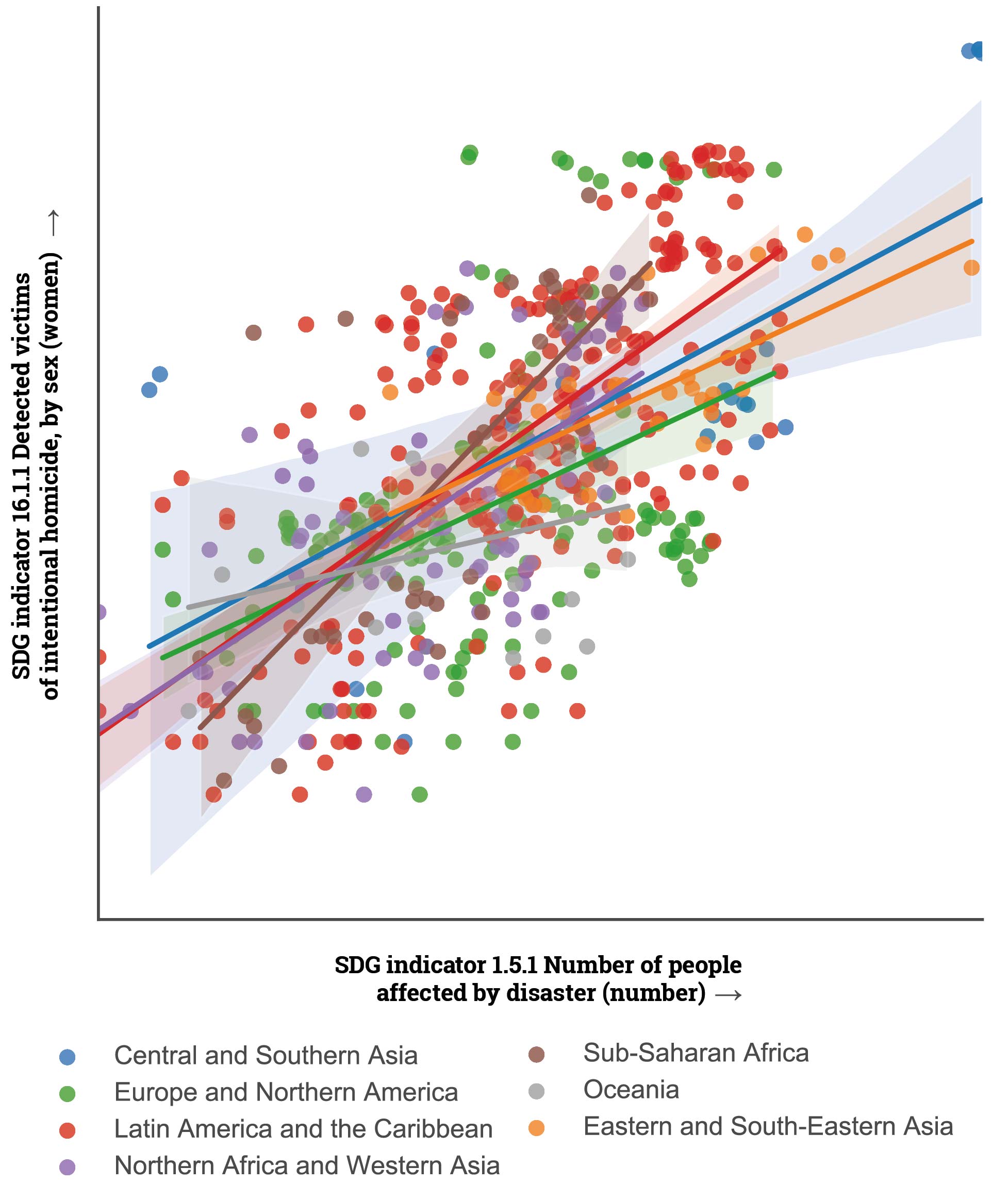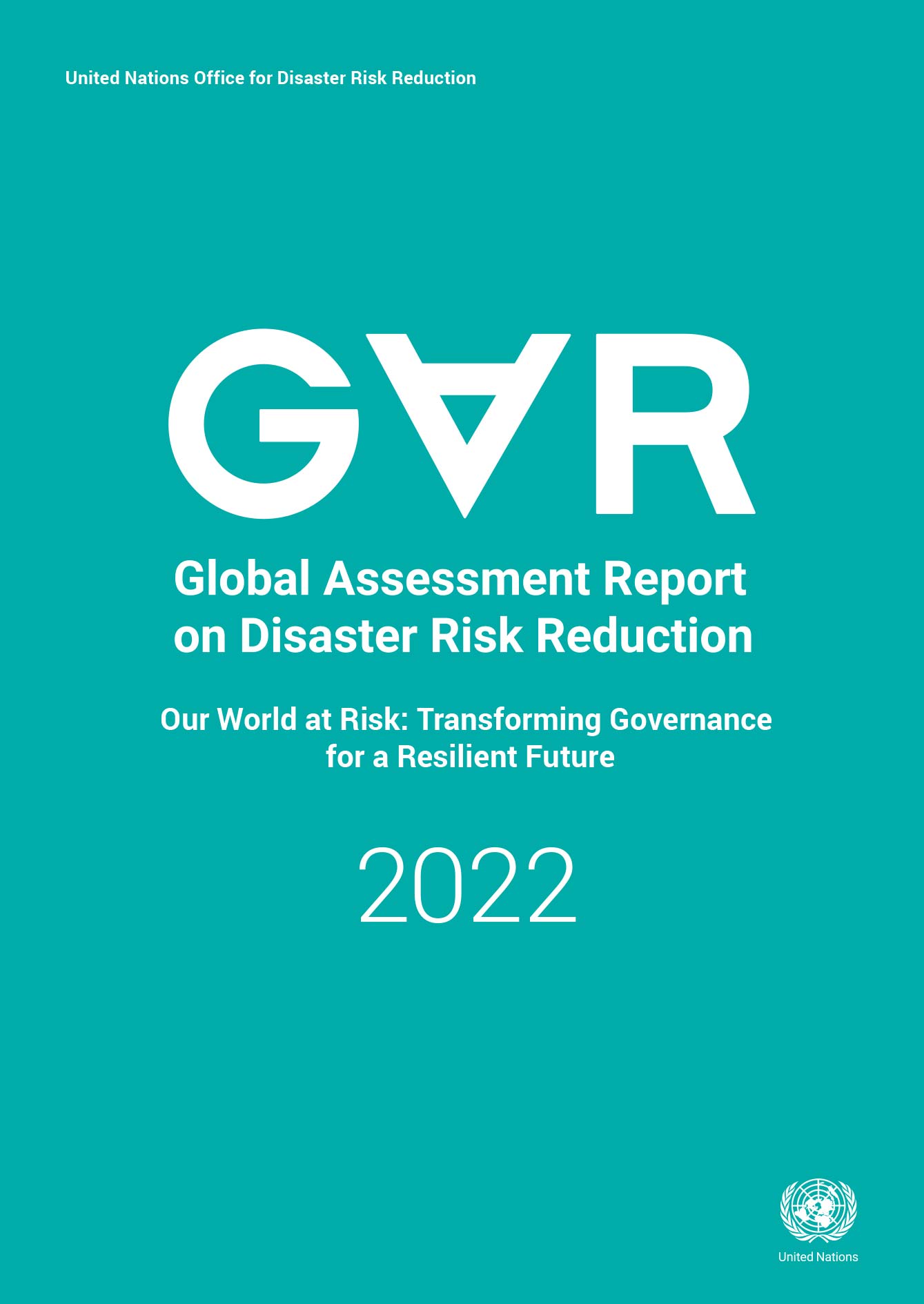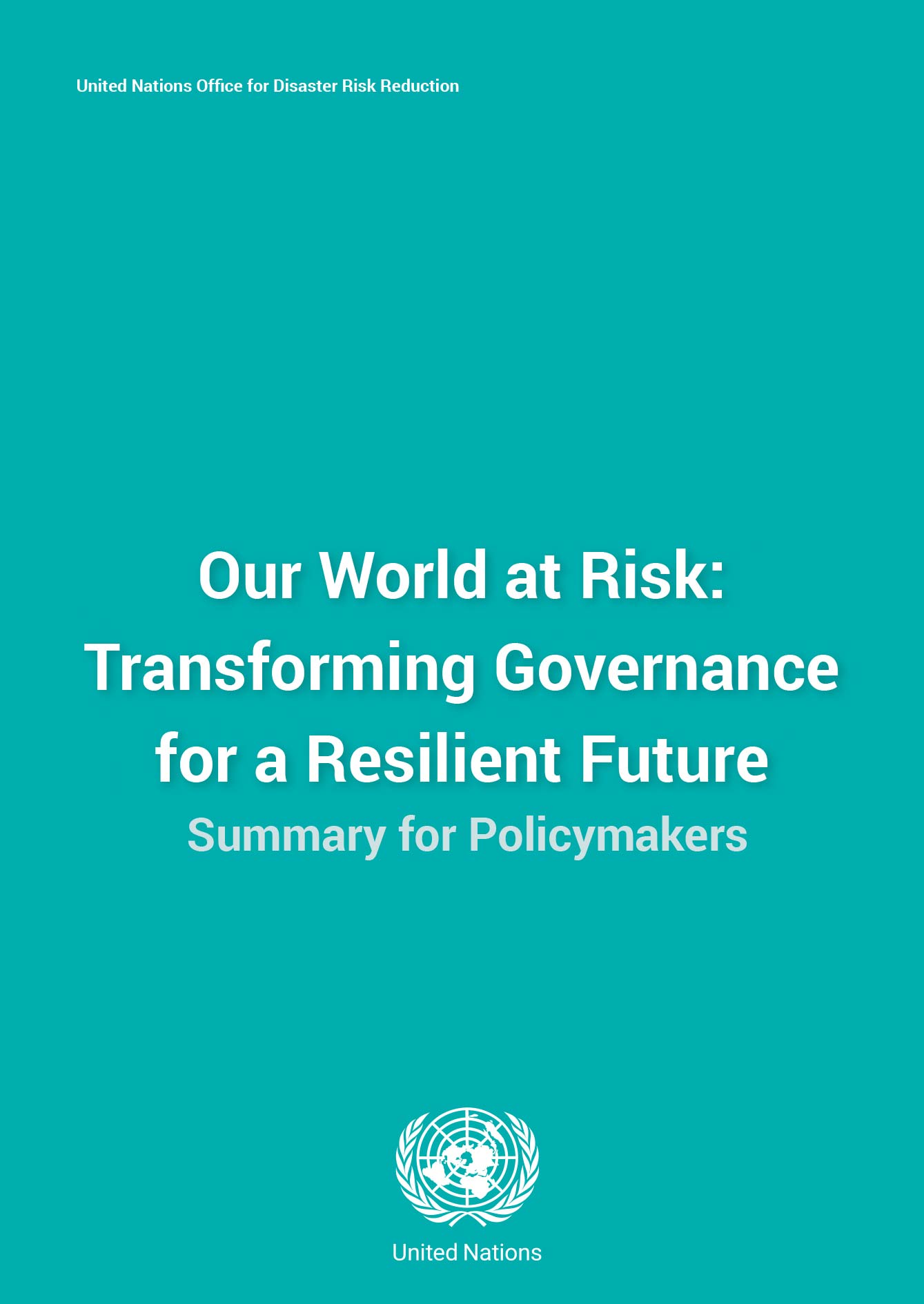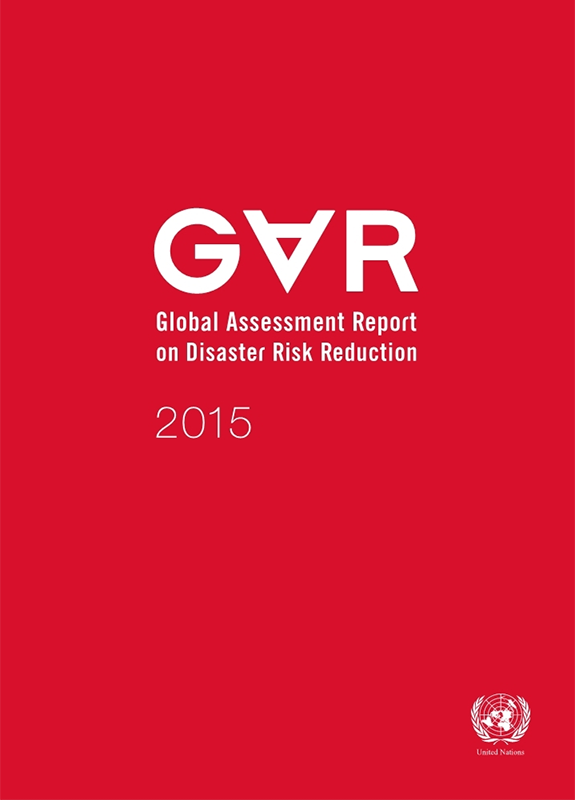Our World at Risk
Transforming Governance for a Resilient Future
Despite commitments to build resilience, tackle climate change and create sustainable development pathways, current societal, political and economic choices are doing the reverse. This jeopardizes not only achievement of the Sendai Framework for Disaster Risk Reduction 2015–2030, but also hinders progress towards the Paris Agreement and the Sustainable Development Goals (SDGs) set out in the Transforming our World: the 2030 Agenda for Sustainable Development.
To change course, new approaches are needed. This will require transformations in what governance systems value and how systemic risk is understood and addressed. Doing more of the same will not be enough.
Risk creation is outstripping risk reduction. Disasters, economic loss and the underlying vulnerabilities that drive risk, such as poverty and inequality, are increasing just as ecosystems and biospheres are at risk of collapse. Global systems are becoming more connected and therefore more vulnerable in an uncertain risk landscape. COVID-19 spread quickly and relentlessly into every corner of the world, and global risks like climate change are having major impacts in every locality. Indirect, cascading impacts can be significant.
Without increased action to build resilience to systemic risk, the SDGs cannot be achieved.
Investment in understanding risk is the foundation for sustainable development. However, this needs to link to a reworking of financial and governance systems to account for the real costs of current inaction to address risks like climate change. Without this, financial balance sheets and governance decision-making will remain fragmented and be rendered increasingly inaccurate and ineffective.
#StopTheSpiral #GAR2022
It is not inevitable that risk continues to grow. The best defence against systemic risk is to transform systems to make them more resilient.
Policy and personal action now can reverse this trend, but only if systemic risk is better understood and risk reduction action is accelerated. The fundamental equation that risk is a function of a hazard event combined with vulnerability and exposure has not changed. However, systemic risk occurs in today’s globalized world through interconnected digital and physical infrastructures, globally integrated supply chains and factors such as urbanization and increased human mobility.
A Foreword from United Nations Secretary-General António Guterres
Nothing undermines sustainable development like disasters. This sixth edition of the United Nations Global Assessment Report on Disaster Risk Reduction – Our World at Risk: Transforming Governance for a Resilient Future comes at a critical time for the future of humanity.
The report offers valuable recommendations to reduce risk and increase resilience. It also details how innovations in systemic risk modelling offer a promising mechanism to better anticipate and respond to risk.

The Challenge
Human action is creating greater and more dangerous risk, and pushing the planet towards existential and ecosystem limits. Risk reduction needs to be at the core of action to accelerate climate change action and achieve the SDGs.
If current trends continue, the number of disasters per year globally may increase from around 400 in 2015 to 560 per year by 2030 – a projected increase of 40% during the lifetime of the Sendai Framework.
For droughts, there is a large year-on-year variation, but current trends indicate a likely increase of more than 30% between 2000 and 2030 (from an average of 16 drought events per year during 2001–2010 to 21 per year by 2030).
The number of extreme temperature events per year is also increasing, and based on current trends will almost triple between 2001 and 2030. Disasters have negative impacts on biodiversity and environmental sustainability.
These trend lines do not take into account future climate change impacts, which are accelerating the pace and severity of hazard events, nor the fact that current choices mean the world is set to exceed the Paris Agreement’s global average maximum temperature increase target of 1.5°C by the early 2030s (IPCC, 2021).
Systemic risk cannot be eliminated entirely, but it can be reduced and addressed more effectively. Addressing systemic risk requires building on existing risk reduction know-how, and also developing enhanced approaches to address the characteristics of systemic risk such as its cascading effects and inherent complexity and uncertainty.

Source: Adapted from Thalheimer et al. (2022)
The costs of disasters are felt across almost all areas of sustainable development. As the world urbanizes, risk is being concentrated in densely populated areas, many of which are not designed to withstand their current levels of hazard exposure, let alone those anticipated as a result of climate change.
The indirect impacts of disasters can also have wide-ranging cascading impacts on other aspects of structural or social inequality.

Research shows that violence against women and girls increases in the aftermath of disasters. At the extreme end of the scale, this takes the form of intentional homicides.
Source: United Nations Department of Economic and Social Affairs analysis based on Global Sustainable Development Goal Indicators Database (UN DESA, 2021)
Calls to action
In the face of global systemic risk, governance systems must quickly evolve and recognize that the challenges for the economy, environment and equality can no longer be separated. Conventional approaches to risk governance have tended to be based on linear or well- established cause-and-effect relationships. By contrast, systemic risk governance needs to recognize complex causal structures, dynamic evolutions and cascading or compound impacts. The recommendations of GAR2022 take the form of a call to action.
Action 1:
Measure what we value
The world is not on track to reduce risk. The costs of disasters are increasing in both social and economic terms, threatening sustainable development (GAR2022, Chapters 2 and 3). Balance sheets ignore key variables, particularly undervaluing climate change risk, costs to ecosystems and the positive social benefits of risk reduction. The real costs of extensive risk are especially undervalued, and this gap is widening as major climate change impacts such as sea-level rise gather pace. To help measure what we value, key actions are to:
1.1 Rework financial systems to account for the real costs of risk, particularly long-term risks, and rework investment and insurance systems to incentivize risk reduction
Governments and the financial industry urgently need to improve how they account for the extent of financial assets at risk under various future climate change scenarios. Social and environmental impact assessments undertaken during the initiation of projects need to be extended to include regular reporting by the public sector, major companies, investments and pension funds. Risk myopia means there are few safe options offered for risk-resilient investments. Just as green bonds helped accelerate the finance of renewable energy, similar financial products are needed to incentivize and ease investment that is resilient to disaster risk and climate change.
1.2 Adapt national fiscal planning and risk financing to consider risk and uncertainty
Public sector finance “stress-testing” methodologies need to be extended to learn from the COVID-19 pandemic, and to test for a wider range of systemic risks with potentially cascading impacts. National budgets also need to evolve to include risk and uncertainty components, so financial planners can become more adept at adaptive planning and are better able to pivot resources in crisis situations.

Action 2:
Design systems to factor in how human minds make decisions about risk
Policymakers and providers of disaster risk reduction products and services to households and communities continue to undervalue how risk perceptions, including cognitive biases, influence decision-making. To help design systems that factor in how human minds make decisions about risk, key actions are to:
2.1 Recognize the role of people’s perceptions of risk and biases to close the gap between intention and action in reducing risk
Adjusting how insurance products are marketed can have a transformative impact on ensuring risk-resilient investment. This includes reframing risk approaches such as using “opt-out” rather than “opt-in” schemes for flood insurance (GAR2022, Chapters 8 and 11).
Improving codes and standards, and also the communication around why they are necessary, is key. For example, after the 2010 earthquake and tsunami, the Government of Chile helped incentivize safe construction by providing funds to poor families to cover the cost of “half a good house” that adhered to building code, but which also allowed personalization of homes by owners (GAR2022, Chapter 4).
2.2 Recognize the value of risk analytics as a tool but not a panacea
Lessons learned from the COVID-19 pandemic show that the success rates of models were uneven in predicting the spread of the disease within and among countries. Decision makers went from an over-reliance on models to extreme scepticism about their utility. Modelling tools can help people think about things in a better way, but they cannot predict the future with granular accuracy. No models are 100% reliable. However, they are essential tools as long as the people who interpret them do not have unrealistic expectations of their omnipotence or dismiss them. Governments can, and should, invest in data analytics, but only if quality models and big data use are combined with methods to draw on local knowledge, community feedback and expert opinion.
Action 3:
Reconfigure governance and financial systems to work across silos and design in
consultation with affected people
Governance and financial systems are not yet embracing transdisciplinary approaches and tend to take top-down approaches. To help reconfigure governance and financial systems to work across silos, and design in consultation with affected people, key actions are to:
3.1 Embrace a new “risk language” that cuts across multiple disciplines
Disaster risk management actors and other sectors speak differently about risk and too often operate in sectoral silos. There is a need to look more at systems, not individual hazards, and to work across disciplines. This requires increased efforts to create common terminologies and provide open access data across disciplines to create shared knowledge, encourage lateral collaboration and speed up the pace of learning. Disaster risk modellers have been learning from tools developed to measure cascading effects during the last financial crisis and from enterprise risk management approaches.
But this learning needs to go both ways between governments and communities, and be built into planning and budgeting processes (GAR2022, Chapter 11).
At the global level, initiatives such as the UNDRR and International Science Council joint Hazard Definition and Classification Review, the new Centre of Excellence for Climate and Disaster Resilience established by UNDRR and the World Meteorological Organization (GAR2022, Chapter 1) and similar inter-agency collaborations that upgrade disaster damage and loss reporting are helping to increase the interoperability and utility of data systems. Such efforts need to be supported to enable enhanced risk understanding at a global level.
3.2 Step up participation, transparency and citizen dialogue in risk decision-making to accelerate learning and necessary adjustments
Modern technology provides opportunities to accelerate learning and to quickly pick up signals essential for effective risk management in an uncertain future. But acting on these signals requires nuanced forms of communication with the public, and particularly better communication with higher-risk groups. Enhanced social protection systems targeted towards at-risk groups can be a good vehicle for better understanding who is most vulnerable to emerging risks and for ensuring effective anticipatory action to prevent acute humanitarian crises.
3.3 Enhance multi-scale risk management
Rifts can emerge between the national and local levels during major crises, as was the case in many jurisdictions during the COVID-19 crisis. Autonomy for local-level action is essential.
More emphasis is required in scenario planning to manage extensive disasters and to handle governance issues resulting from cascading impacts. For example, adjustments made to health systems based on local knowledge and feedback were essential to building trust during the 2014 Ebola outbreak in Liberia (GAR2022, Chapter 7). In Canada, an InterSectoral Flood Network of Quebec presents modelling data and also explicitly facilitates co-training among members to promote a vision that is systemic and intersectoral, engaging universities and various socioeconomic partners and disciplines (GAR2022, Chapter 10).
How to better address systemic risk
Key case examples from GAR2022 with links to the SDGs.
The baseline is established.
The time for action is now.
GAR2022 outlines how immediate action around these three areas can help governments, local communities and individuals better position themselves to cope with a volatile, uncertain future.
The keys to building resilience and accelerating sustainable development are measuring what we value, designing systems around the way people make decisions on risk, and reconfiguring governance and financial systems to work collaboratively and across silos. As climate change impacts gather pace, we know what is at stake for future generations.
Download the Report
English
French
Spanish
Chinese
Russian
Arabic
Summary for Policy Makers
English
French
Spanish
Chinese
Russian
Arabic
GAR2022 Slide deck
English
French
Press contacts and materials
Contributing Papers
Media contact and materials
The UN Global Assessment Report on Disaster Risk Reduction (GAR) is the flagship report of the United Nations on worldwide efforts to reduce disaster risk. The GAR is published biennially by the UN Office for Disaster Risk Reduction (UNDRR), and is the product of the contributions of nations, public and private disaster risk-related science and research, amongst others.
UN Office for Disaster Risk Reduction (UNDRR)
Rosalind Cook
Public Information Officer
rosalind.cook@un.org
Omar Amach
Public Information Officer
omar.amach@un.org

Humanity’s broken risk perception is reversing global progress in a ‘spiral of self-destruction’, finds new UN report
World could undo social and economic advances and face 1.5 disasters a day by 2030, according to UN’s flagship Global Assessment Report.

GAR2022 Report

Summary for Policy Makers

GAR2022 Slide deck














